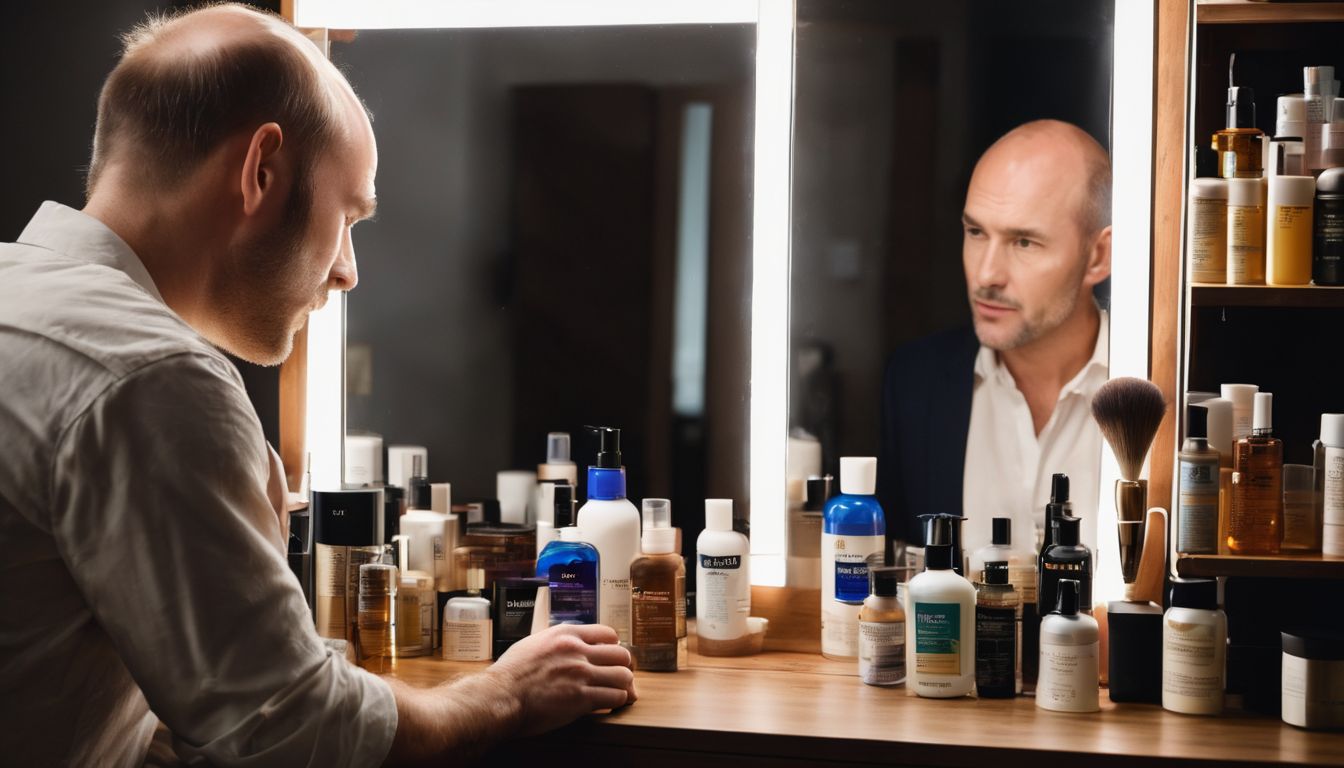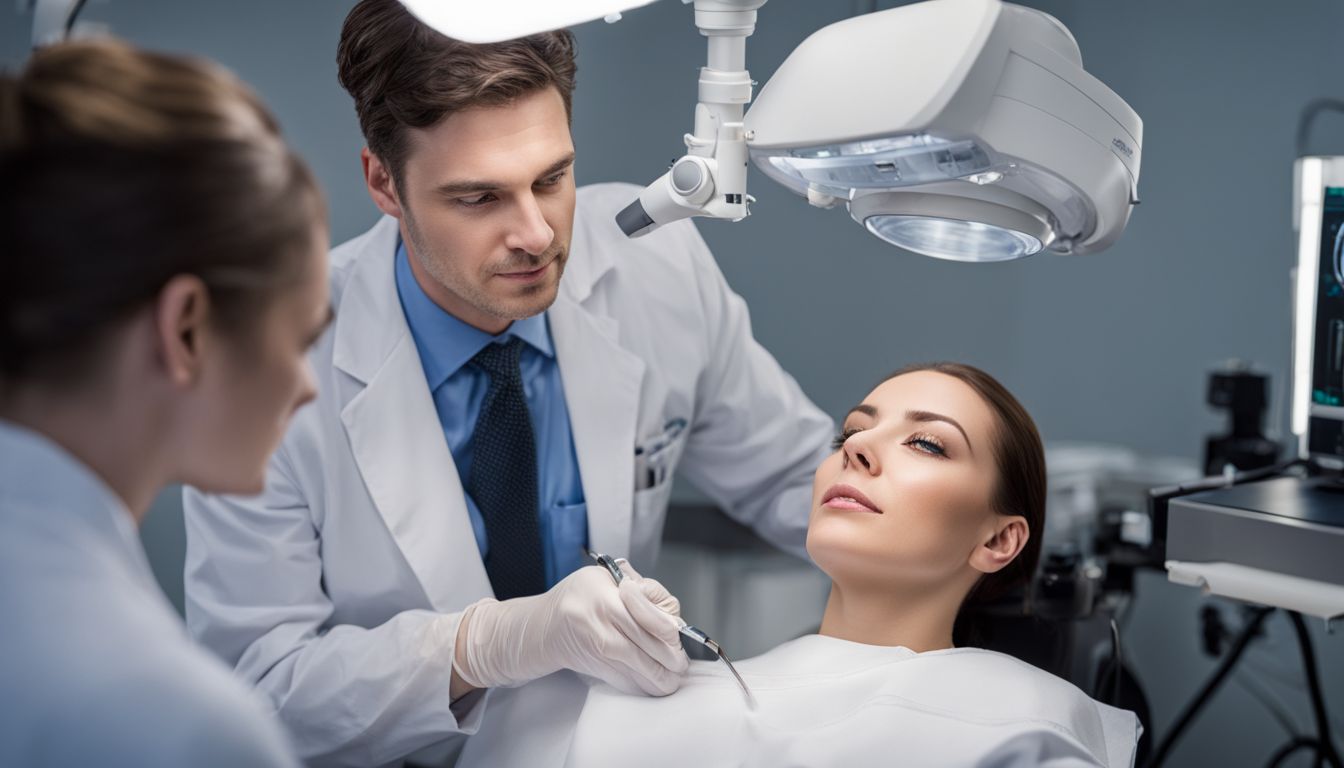
Hair loss is a concern shared by many, leaving them searching for answers and options. Surprisingly, pattern baldness affects a large portion of the population, with unique manifestations between males and females.
This article will delve into the causes, symptoms, and treatments available to manage this common condition effectively. Keep reading; a fuller understanding is just ahead.
Key Takeaways
- Pattern baldness, also known as androgenetic alopecia, happens when hair thins over time. Both men and women can get it, but it looks different on each.
- Many things cause pattern baldness like genes, hormones, age, medicine, medical issues, diet and stress. Hormones called DHT can make hair thin out more in some people.
- To spot pattern baldness early look for a receding hairline or less hair at the crown for men. Women might see their part getting wider or thinning across the top of the head.
- You can treat pattern baldness with stuff like minoxidil that you buy at the store or medicines doctors give you like finasteride. Some people try PRP shots or laser therapy too.
- If other treatments don’t work well enough some choose to have surgery to move hairs from one place on their head to another where there is less hair.
Understanding Pattern Baldness

Pattern baldness, also known as androgenetic alopecia, is a common condition that affects both men and women. It is characterized by the gradual thinning of hair on the scalp, resulting in patterned baldness over time.
While genetics play a significant role in its development, hormonal imbalances, aging, medications, medical conditions, and lifestyle factors also contribute to this condition. Understanding the complexity of pattern baldness can help individuals take proactive steps towards prevention and management.
Definition of Male and Female Pattern Baldness
Male pattern baldness, also called androgenetic alopecia, often starts with a receding hairline and thinning on the top of the head. In time, this can lead to a bald spot and possibly complete baldness on the scalp.
It’s linked to genes and male sex hormones.
Female pattern baldness is similar but not quite the same as in men. Women usually see their hair getting thinner all over but mainly at the top of their heads. They may notice a widening part that looks like a Christmas tree if seen from above.
This type isn’t about going completely bald but more about losing volume and coverage.
Both types are pretty common, especially as people get older. Understanding these differences helps us figure out what might work best for tackling each one. Next up, let’s break down some myths around pattern baldness.
Common Misconceptions
Knowing what causes pattern baldness helps us clear up some wrong ideas. Many people think male pattern hair loss is only because of androgens, but genes are also key. This type of hair loss does not just happen because a man has more hormones like testosterone.
For both men and women, losing hair does not start at the same age or in the same way. Men might see their hair start to thin earlier, often at the front and top of their heads. Women usually notice it later in life with thinning on top of their scalp after menopause.
Some believe wearing hats can cause balding, but this is not true; your hat won’t make you lose hair.
Causes of Pattern Baldness

Pattern baldness can be caused by a variety of factors, including genetics and heredity, hormonal influences and imbalances, the aging process, medications and medical conditions, as well as lifestyle factors such as diet and stress.
Genetics and Heredity
Your genes play a big part in pattern baldness. Just like you can inherit your dad’s blue eyes or your mom’s smile, hair loss can be passed down through families. Some people have a change in their DNA that makes them more likely to lose their hair.
Scientists found that changes in two areas of the gene code, called _AR_ and _CYP19A1_, are linked with hair loss in men and women.
Men sometimes get male pattern baldness because of a hormone called dihydroxytestosterone (DHT). This hormone can make it hard for hair follicles to grow new hairs, which can lead to thinning or bald spots on the scalp.
Women might see their hair getting thinner too, especially after menopause when hormone levels change. Remember, while not everyone will get pattern baldness even if it runs in the family, having relatives with thinning hair does raise your chances of experiencing it yourself.
Hormonal Influences and Imbalances
Genetics are not the only thing that can cause hair to thin or fall out. Hormones also play a big part in pattern baldness. In men, a hormone called dihydrotestosterone (DHT) is often at fault.
If your body makes too much DHT, it can shrink hair follicles. This makes it hard for new hair to grow.
For women, things are a bit more complex because their hormones change throughout life. High levels of androgens, which are male hormones that women also have, can lead to hair loss.
Conditions like polycystic ovary syndrome (PCOS) make these hormone levels go up and may cause thinning hair on the scalp.
Hormone changes during menopause can also affect hair growth in postmenopausal women. These changes might lead to female-pattern baldness where the hair gets thinner all over the head but doesn’t always pull back from the forehead like in males.
Treatments for hormonal imbalances include medicines that block DHT or balance hormone levels. Doctors sometimes suggest using minoxidil foam or taking antiandrogen drugs to help stop further hair loss and possibly bring back some of the lost hair.
The Role of Aging
As hair loss is often attributed to various factors, including hormonal influences and imbalances, aging also plays a significant role in the development of pattern baldness. As individuals age, there is a natural process characterized by the gradual thinning of hair on the scalp.
This occurs due to a decrease in blood flow to the hair follicles over time, leading to a reduction in the size of hair follicles and their ability to produce thick terminal hairs.
The shift from terminal hairs to finer vellus hairs is linked with the natural aging process.
Furthermore, as people age, they may experience changes in hormone levels which can impact pattern baldness. For instance, fluctuations in hormone levels such as increased dihydrotestosterone (DHT), a derivative of testosterone sensitive to hair follicles, can contribute to the progressive miniaturization of hair follicles over time.
Medications and Medical Conditions
As we consider the impact of medications and medical conditions on pattern baldness, it’s important to note that certain drugs can contribute to hair loss. For example, some medications used for treating high blood pressure, heart conditions, depression, arthritis, and cancer have been linked to hair thinning or loss.
Additionally, medical conditions such as thyroid disorders, hormonal imbalances (such as those seen in polycystic ovarian syndrome), autoimmune diseases like lupus or alopecia areata can also play a role in triggering hair loss.
Moreover, it’s noteworthy that treatments involving testosterone replacement therapy and anabolic steroids may lead to male pattern baldness due to their influence on hormone levels.
Lifestyle Factors: Diet and Stress
Diet and stress are important lifestyle factors that can contribute to pattern baldness. Poor nutrition, specifically deficiencies in certain vitamins and minerals, can impact hair health.
Stress can lead to hormone imbalances, which may trigger or worsen pattern hair loss. It’s essential to maintain a balanced diet rich in nutrients and manage stress effectively for overall well-being, including healthy hair growth.
Furthermore, studies have shown that chronic stress can disrupt the natural hair growth cycle by pushing more hairs into the shedding phase. This highlights the significance of addressing both dietary habits and stress management techniques as part of proactive care for individuals concerned about pattern baldness.
Identifying the Signs of Pattern Baldness
The signs of pattern baldness differ between males and females, with hair thinning at the crown being a common indication in females, while males typically experience a receding hairline and thinning at the crown.
Recognizing these patterns is crucial for early diagnosis and treatment.

Hair Thinning at the Crown in Females
Female pattern hair loss commonly involves thinning at the top of the head, known as the crown. This type of hair loss can be distressing for women and is often characterized by widening parts or see-through scalp skin.
It’s important to note that this hair thinning primarily affects the vertex and midfrontal scalp in females.
Diagnosis of female pattern hair loss typically involves a thorough history, physical examination, hair-pull test, dermoscopy, and laboratory testing. Once diagnosed, treatment primarily includes using topical minoxidil to help slow down further thinning and promote regrowth.
Receding Hairline and Thinning Crown in Males
Men experiencing male pattern hair loss may notice their hairline starting to recede, often forming an “M” shape. Additionally, they might observe thinning at the crown of the head, which can gradually progress over time.
These are classic signs of androgenic alopecia in males. As male pattern hair loss advances, the central part of the scalp becomes more visible due to ongoing hair thinning.
Genetic variations related to androgen receptors play a key role in the development of male pattern hair loss. Androgens like testosterone are believed to be essential for this type of balding.
Diagnosing Pattern Baldness

Diagnosing pattern baldness involves a clinical diagnosis and history, as well as specific tests such as the hair-pull test, dermoscopy, scalp biopsy, and laboratory testing to determine the underlying causes of hair loss.
Identifying the root cause is crucial in developing an effective treatment plan.
Clinical Diagnosis and History
Diagnosing pattern hair loss involves a thorough history, physical examination, and tests. The healthcare provider may look for family history of hair loss, any medications or supplements being taken, and other medical conditions.
A hair-pull test can determine the condition of the hair and scalp, while dermoscopy helps examine the scalp more closely. Laboratory testing can help identify any underlying hormonal imbalances or medical conditions that could be contributing to the hair loss.
In challenging cases, a scalp biopsy may be necessary for an accurate diagnosis.
The Hair-pull Test and Dermoscopy
The hair-pull test is a simple way to determine if active hair loss is happening. By gently pulling on a small amount of hair near the scalp, we can see how many hairs are being shed and assess the condition of the roots.
This test helps in identifying conditions like telogen effluvium or androgenetic alopecia. Dermoscopy, using a special tool called a dermatoscope, allows us to closely examine the skin of the scalp and identify structures that are not visible to the naked eye.
It assists in diagnosing male or female pattern hair loss by revealing epidermal and dermal structures that provide crucial information about the health of the scalp.
Scalp Biopsy and Laboratory Testing
Scalp Biopsy and Laboratory Testing are crucial for diagnosing pattern baldness. Here’s a detailed look at the process:
- Scalp Biopsy: A small part of the scalp is removed to examine hair follicles and surrounding tissues under a microscope for signs of balding patterns.
- Laboratory Testing: Blood tests may be conducted to check hormone levels, especially androgens like DHT, which can contribute to hair loss.
- AR Gene Variation Analysis: Genetic testing can identify variations in the androgen receptor (AR) gene that may influence hair loss susceptibility.
- Hormone Panel: Assessing levels of hormones like testosterone, dihydrotestosterone (DHT), and estrogen may help pinpoint hormonal imbalances linked to baldness.
- Scalp Microbiome Analysis: Understanding the scalp’s microbial community through advanced testing can provide insights into its role in hair health.
- Inflammation Markers: Tests for markers of inflammation might be conducted as chronic scalp inflammation can contribute to hair thinning or loss.
Treatment Options for Pattern Baldness
There are several treatment options available for pattern baldness, including over-the-counter treatments like minoxidil, prescription medications such as finasteride and dutasteride, alternative therapies like PRP and low-level laser therapy, and surgical interventions like hair transplants.
It’s important to discuss these options with a healthcare provider to determine the best course of action for managing pattern baldness.
Over-the-counter Treatments: Minoxidil
Minoxidil, also known as Rogaine, stands as a gold standard treatment for both male and female pattern baldness. It’s an over-the-counter option that effectively combats androgenetic alopecia in men and women.
For more effective hair loss treatment, women are advised to use the 5 percent minoxidil product. Therefore, incorporating minoxidil into your hair care routine can offer a viable solution to combat pattern baldness.
To further enhance its efficacy in treating hair loss, especially for women dealing with androgenetic alopecia, utilizing the 5 percent minoxidil product is crucial. The availability of minoxidil as an over-the-counter medication makes it easily accessible for individuals seeking to address their pattern baldness concerns proactively.
Prescription Medications: Finasteride and Dutasteride
Finasteride and Dutasteride are prescription medications commonly used to treat pattern baldness in men. They work by preventing the conversion of testosterone into dihydrotestosterone (DHT), a hormone that contributes to hair loss.
Finasteride is available in oral form, while Dutasteride is another medication that works similarly but inhibits two types of enzymes instead of just one like Finasteride. These drugs have been shown to effectively slow down hair loss and promote hair regrowth in some individuals, making them popular choices for male pattern baldness treatment.
It’s important to note that these medications may have potential side effects such as sexual dysfunction or breast tenderness, so consulting a healthcare provider before starting the use of these prescription drugs is crucial.
Both Finasteride and Dutasteride are FDA-approved for treating benign prostatic hyperplasia (BPH), but they can also be prescribed off-label for female pattern hair loss due to their ability to block DHT.
Alternative Therapies: PRP and Low-level Laser Therapy
After considering prescription medications like Finasteride and Dutasteride, it’s important to explore alternative therapies for pattern baldness. Platelet-rich plasma (PRP) therapy and low-level laser therapy are gaining attention as promising options for hair regrowth with minimal side effects.
PRP therapy involves injecting a concentration of platelets from the patient’s blood into the scalp, promoting wound healing and potentially stimulating hair growth. On the other hand, low-level laser therapy utilizes safe levels of light to stimulate hair follicles, also showing potential for reducing hair loss and encouraging new follicle development.
Both these alternative therapies present hopeful avenues for individuals seeking non-invasive treatments for pattern baldness. With ongoing research and clinical trials supporting their effectiveness in stimulating hair regrowth, PRP and low-level laser therapy offer promising solutions worth considering alongside traditional medical interventions.
Surgical Interventions: Hair Transplants
When other medical interventions fail to provide desired results, surgical hair transplants offer a more permanent solution. A key fact to note is that this procedure involves moving healthy hair follicles from an area of the scalp resistant to balding, typically the back or sides of the head, and implanting them into areas where hair is thinning or receding.
This process creates a lasting improvement in hair coverage and density by utilizing one’s natural hair growth. Early detection and intervention play significant roles in determining the success and satisfaction of this surgical option.
Remember, it’s important for individuals considering this approach to consult with a qualified healthcare provider specializing in hair restoration surgery before making any decisions.
Managing Pattern Baldness
To manage pattern baldness, individuals can consider using cosmetic aids and hairstyling tips to improve the appearance of their hair. Additionally, it’s important to address any mental health and self-esteem considerations that may arise from experiencing hair loss.
Cosmetic Aids and Hairstyling Tips
To maintain the appearance of thinning hair, consider the following cosmetic aids and hairstyling tips:
- Use scalp colorants or tinted powders to camouflage areas of sparse hair, creating the illusion of fullness and volume. These products can blend seamlessly with existing hair color for a natural look.
- Explore the option of wigs, hair extensions, or hairpieces to add thickness and coverage to areas affected by pattern baldness. Quality pieces are designed to appear indistinguishable from natural hair.
- Experiment with hairstyles that can help conceal thinning areas, such as layered cuts or strategic parting that creates the illusion of thicker hair volume. Professional hairstylists can provide guidance on suitable cuts and styles.
- Select volumizing shampoos and conditioners formulated to enhance the appearance of fuller, thicker hair. Such products often contain ingredients designed to boost overall hair health and improve manageability.
- Consider using styling techniques like blow – drying with a round brush or applying volumizing mousse to create lift at the roots, adding dimension and volume to fine or thinning hair.
Mental Health and Self-Esteem Considerations
When dealing with pattern hair loss, it’s crucial to acknowledge its impact on mental health and self-esteem. Both men and women may experience lower self-esteem due to hair loss, leading to decreased body image satisfaction and increased stress levels.
It’s essential to recognize the emotional toll that pattern baldness can have on individuals’ quality of life.
Furthermore, understanding the psychological effects of hair loss can help in providing holistic care for those affected. By considering mental health and self-esteem alongside treatment options, healthcare providers can address not just the physical aspects but also the emotional well-being of individuals experiencing pattern baldness.
Prevention and Proactive Care
Taking proactive steps to prevent pattern baldness can include maintaining a healthy lifestyle, managing stress levels, and seeking professional advice if you notice early signs of hair loss.
Incorporating a balanced diet, avoiding harsh hair treatments, and using appropriate hair care products can also contribute to preventing or slowing down the progression of pattern baldness.
Can Pattern Baldness be Prevented?
Preventing pattern baldness is challenging due to its strong genetic influence, but certain proactive measures can help minimize its impact. Maintaining a healthy lifestyle with a balanced diet and managing stress levels may support overall hair health.
Additionally, early detection through regular scalp examinations by a healthcare provider can aid in timely intervention, potentially slowing down the progression of balding. Understanding one’s family history of hair loss and seeking professional advice at the first signs of thinning can also contribute to proactive management.
Although preventing pattern baldness entirely may not be achievable, integrating these practices into one’s routine can potentially mitigate its effects on hair density and quality.
When to See a Healthcare Provider
Early detection and intervention are crucial in managing pattern baldness. If you notice significant hair thinning, a receding hairline, or any signs of pattern baldness, it’s important to seek medical advice promptly. Here are the circumstances under which you should consult a healthcare provider:
- Persistent and worsening hair loss despite trying over-the-counter treatments like minoxidil or other home remedies.
- Sudden and unexplained hair loss accompanied by other symptoms such as skin changes, pain, or unusual patterns of shedding.
- Noticeable changes in the quality and texture of the scalp or hair that raise concerns about an underlying medical condition.
- History of pattern baldness in your family, especially if you observe early onset or rapid progression of hair loss.
- Emotional distress or psychological impact due to hair loss affecting your self-esteem and well-being.
Conclusion
Understanding male and female pattern baldness provides valuable insights into the causes, symptoms, and treatment options. Pattern hair loss is a common condition that can affect self-esteem and mental well-being.
By debunking myths and providing actionable guidance, individuals can make informed decisions about managing hair loss. With data-driven knowledge and proactive care, people can navigate the challenges of pattern baldness with confidence while seeking appropriate medical advice when needed.
FAQs
1. What causes hair to start falling out in men and women?
Hair loss in men and women can be due to higher androgen levels, emotional stress, or not getting enough of the right food nutrients. Some people have health problems like scarring alopecia, which is when scars make hair fall out.
2. How do I know if I have male or female pattern baldness?
If you see your hairline receding or more hair is thinning all over your head, these could be signs of male or female pattern baldness. Men might lose hair on their temples first while women may notice a wide parting in their hair.
3. Can a doctor tell me why my hair is falling out?
Yes! A dermatologist can check for things like hormonal changes from puberty, high androgen levels related to conditions like hirsutism or polycystic ovary syndrome (PCOS), and other reasons like pulling your own hair (trichotillomania) that might cause losing hair.
4. Are there treatments that can help with my baldness?
Treatments are available! Options include medicine such as spironolactone (Aldactone) for women with too much androgens; Proscar, which helps by blocking hormone effects on the scalp; platelet-rich plasma therapy; or even surgery like a procedure called “hair transplantation” where doctors move hairs to fill in bare spots.
5. Are there any side effects from treatments for baldness?
Some treatments might have side effects – taking medicines could lead to issues like erectile dysfunction or affect sex drive for some; surgeries may also carry risks so always talk with your doctor before starting treatment.
6. Should I change anything else besides treatment to help my baldness?
Changing how you care for your scalp might help too – avoiding harsh styles that pull tight on the roots of your hairs (traction alopecia), keeping away from junk mail products promising quick fixes, treating scalp conditions like seborrheic dermatitis (with dandruff), checking if you need better nutrition through diet are all good steps alongside medical treatments.
References:
- Lolli, F., Pallotti, F., Rossi, A., Fortuna, M. C., Caro, G., Lenzi, A., Sansone, A., & Lombardo, F. (2017). Androgenetic alopecia: a review. Endocrine, 57(1), 9–17. https://doi.org/10.1007/s12020-017-1280-y
- Fabbrocini, G., Cantelli, M., Masarà , A., Annunziata, M. C., Marasca, C., & Cacciapuoti, S. (2018). Female pattern hair loss: A clinical, pathophysiologic, and therapeutic review. International journal of women’s dermatology, 4(4), 203–211. https://doi.org/10.1016/j.ijwd.2018.05.001
- Cranwell W, Sinclair R. Male Androgenetic Alopecia. [Updated 2016 Feb 29]. In: Feingold KR, Anawalt B, Boyce A, et al., editors. Endotext [Internet]. South Dartmouth (MA): MDText.com, Inc.; 2000-. Available from: https://www.ncbi.nlm.nih.gov/books/NBK278957/
- Wirya, C. T., Wu, W., & Wu, K. (2017). Classification of Male-pattern Hair Loss. International journal of trichology, 9(3), 95–100. https://doi.org/10.4103/ijt.ijt_46_17
